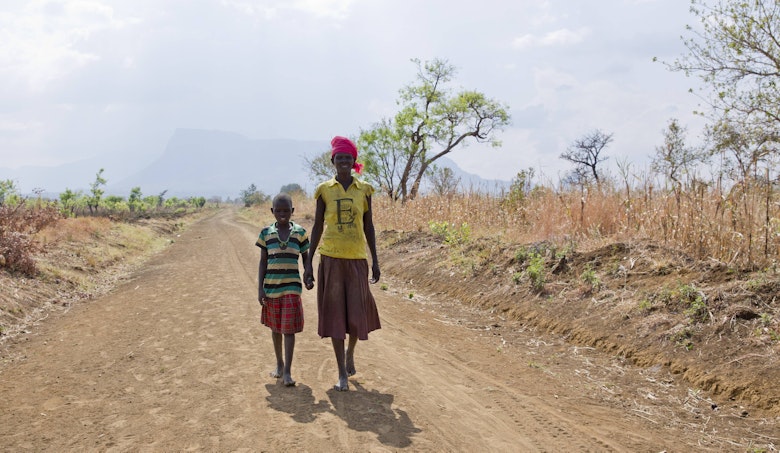Community Action project (Uganda)
The Community Action project is a twenty one months project implemented in Karamoja region by Terre des Hommes Netherlands and Dwelling Places. It aims to reduce child sex trafficking in Napak district (Matanyi, Lokopo, Lopeei and Lorengechora sub-counties) by creating child sex trafficking referral, response and reporting mechanisms that are effectively operating, providing a protective shield for children and reducing their vulnerability. The project is funded by the U.S. Department of State’s Office to Monitor and Combat Trafficking in Persons through the Global Fund to End Modern Slavery (GFEMS).
Why this is important
Child trafficking is common in the impoverished Karamoja region; each year, 400-900 children (90% girls) are trafficked for sexual exploitation, mostly to Kampala. A main source area for the majority of trafficked and exploited children is one particular district in Karamoja region, Napak district. Most Karimojongs are forced to migrate due to insecurity and harsh climatic conditions that have caused drought, poverty and food insecurity in the region. There is also evidence that children are sometimes lured out of Karamoja by their peers, or by individuals promising better opportunities.
Karamoja is the poorest region within Uganda. The majority of Karamoja’s population (51.3%) depends on subsistence farming, which for Napak is next to impossible given the very unpredictable and dry climatic conditions. About 84% of children in Karamoja experience multidimensional poverty, the highest rate in Uganda (Unicef, 2018). In the greater North area of Uganda, less than 50% of girls can read and write and only one in eight children have completed primary school. Nearly 90% of girls aged 10-14 in Karamoja are two years behind in their education or have never been to school. Children who lack adequate education experience higher vulnerability to child sex trafficking.
Prevention and community engagement in the Karamoja region are very low. Communities and schools (primary and secondary) could play a big role in reporting and stopping child sex trafficking, but in Karamoja they are not sufficiently engaged yet. Social norms play an important role, in general girls’ care has low priority.
Child sex trafficking refers to an act of sexually abusing a child for economic gains, where sexual abuse is exchanged for anything of value (money, goods, or services) with the child or a third person(s). Child sex trafficking is the recruitment, harbouring, transportation, provision, obtaining, patronising, soliciting, or maintaining of a child for the purposes of a commercial sex act. It occurs in many forms, for instance; child sexual abuse materials, sexual exploitation of children in travel and tourism, and technology enabled sexual exploitation.
Child sex trafficking constitutes a form of coercion and violence against children, and amounts to a contemporary form of slavery. Child sexual exploitation impacts not only negatively on a child and his/her family, but also on the community, institutions, the private sector and the state. This calls for action, to tackle child sex trafficking.
What we do
The Community Action project will protect 2,000 children at risk in Napak district (in Karamoja) from child sex trafficking.
Key activities include: establishment and adoption of sub-county by-laws on child protection; capacity building of district and sub-county council members to develop, popularise and enforce the child protection ordinances and local by-laws; train parents and caregivers of vulnerable children on how to identify trafficking risks, how to monitor their children and how to follow-up on cases of child sex trafficking; train 200 teachers and 280 students on child sex trafficking and the role they can play in prevention and monitoring of children; organise community dialogues and theatre plays (reaching 10,000 people) on child sex trafficking and the by-laws in order to change negative social norms; support 160 child sex trafficking survivors and 160 parents/caregivers through economic empowerment support; support younger child sex trafficking survivors to re-enter and remain in school.
How we work - multidimensional approach
The project strategy consists of a combination of prevention activities and the promotion of a positive enabling environment through community engagement activities, economic empowerment of survivors, and promotion of education among younger survivors.
Community engagements (on child sex trafficking issues, gender and also the value of education) are combined with strengthening systems at national, district and sub-county levels; and working very closely with the schools to monitor attendance and follow up on children who are not in school. Besides, tailor made psychosocial support, educational and livelihood support is given to intercepted victims to reduce vulnerability. Community child protection champions and the local council members are supported and guided in how to monitor children, report, refer and follow up on any suspected or actual child sex trafficking issues within the villages. To ignite grassroots advocacy, the community is empowered with information on child sex trafficking, its legal frameworks (laws, policies, regulations, etc) and the referral machanism, so that they become active agents passing on the information from person to person, with an increased vigilance in prevention.

